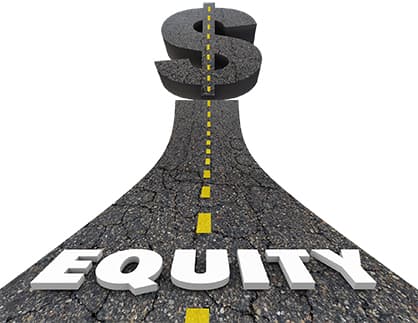Debt to Equity Conversions
 In these investment scenarios, there are times when an organization needs more money than is as of now being produced by its activities; it has two different ways to get it. It can get the cash it needs, known as debt financing. Alternatively, on the other hand, it can sell a share of possession or ownership, alluded to as equity financing. One preferred standpoint of equity financing is that, not at all like acquired cash, the money raised doesn't need to be paid back. That is a noteworthy motivation behind why organizations convert debt to equity.
In these investment scenarios, there are times when an organization needs more money than is as of now being produced by its activities; it has two different ways to get it. It can get the cash it needs, known as debt financing. Alternatively, on the other hand, it can sell a share of possession or ownership, alluded to as equity financing. One preferred standpoint of equity financing is that, not at all like acquired cash, the money raised doesn't need to be paid back. That is a noteworthy motivation behind why organizations convert debt to equity.
Debt-Equity Swaps
A debt to equity swap is a straightforward and since a long time ago utilized strategy for changing over debt to equity. In exchange, an organization concurs with a lender to disregard a few or most of its debt in return for a proprietorship stake in an organization. State an open organization with a present stock cost of $20 owes a bank $1 million. If the organization comes up short on the money to make its debt payments - or that it would merely like to utilize the funds for different things - it could offer the bank 50,000 shares in its stock. The bank surrenders its entitlement to gather the $1 million. However, it is currently a section proprietor of the organization with a stake worth $1 million.
If the company wants a restructuring of the debts and equity mixture for success on a long-term basis, they go for the option of converting the debts to equity or equity to debts as and when the situation demands. The shareholders are given a chance or an opportunity to exchange or transfer the stock or shares that they hold for an anticipated amount of debt in the same company.
Debt to equity swaps is commonly carried out transactions in the financial sector. They empower a borrower to change loans in shares of stock or equity. Most ordinarily, a commercial organization, for example, a bank will hold the new shares after the first debt is changed into equity shares. The lender converts the amount of the loan which is represented by bonds which are outstanding to equity shares when the process of debt to equity takes place. Actual cash is not meant to be exchanged during the process.
To take an example, Let's take a company ‘A’ who owes the lender ‘X’ close to 20 million Dollars. Now, as an alternative to continuing to make payments for the debts, ‘A’ makes an agreement with ‘X’ to give him 2 Million Dollars that is the 10% ownership in ‘A’ as a company in place of rectifying the debt.
In an equity-for-debt swap, an organization's lenders for the most part consent to drop a few or most of the debt in return for equity in the organization.
Debt for equity bargains frequently happens when expansive organizations keep running into money-related inconveniences and regularly result in these organizations being taken over by their key loan bosses. This is for the reason that both the debt and the rest of the benefits in these organizations are significant to the point that there is no favourable position for the lenders to drive the organization into insolvency. Instead, the lenders want to assume responsibility for the business as a going concern. As a result, the first investors' stake in the organization is commonly altogether weakened in these deals and might be wholly disposed of.
Debt for equity swaps are one method for managing home loans. A householder not in a situation to support his debt on a $180,000, contract for instance, may by concurrence with his bank have the estimation of the home loan diminished (state to $135,000 or 75% of the house's present esteem), as an end-result of which the bank will get half of the sum by which any resale esteem, when the house is exchanged, surpasses $135,000.
Debt to Equity Swap is a method of restructuring the financial system from the area of debt restructuring. It usually is applying in situations when an organization is looked with economic issues, when over-indebted, can't reimburse existing advances on time, has diminished liquidity and when there is no plausibility for additional indebtedness. The critical point is to trade the current debt for proprietorship share, by what the past lenders turn out to be new co-proprietors of the organization.
Previously, this methodology was connected just to large organizations, however starting late, it has been available as a choice of finance restructuring for medium-sized and small organizations as well. Debt to equity swap frequently happens when the organization is stuck in an unfortunate situation and is generally powerless to reimburse the creditor's anything without going bankrupt. The quantity of shares granted is controlled by the measure of outstanding obligation and the stock's esteem. The estimation of the swap is resolved often at current market rates, yet the board may offer higher trade esteems to lure offer and obligation holders into taking an interest in the swap.
This can likewise help organizations to support their bond evaluations or change their capital structure to exploit current stock valuation.
Bonds which are convertible
 Organizations can conduct equity to debt conversions early by issuing convertible bonds. Investors who purchase securities are loaning cash to the guarantor. They recover their money when the bond develops; meanwhile, they gain a premium. The Investors who claim convertible bonds, be that as it may, likewise have the choice of reclaiming those bonds for a specific number of offers of organization stock - state, two shares for each $100 worth of bonds. On the off chance that the convertible bond is "callable," the issuing organization can drive bondholders to change over their bonds into offers.
Organizations can conduct equity to debt conversions early by issuing convertible bonds. Investors who purchase securities are loaning cash to the guarantor. They recover their money when the bond develops; meanwhile, they gain a premium. The Investors who claim convertible bonds, be that as it may, likewise have the choice of reclaiming those bonds for a specific number of offers of organization stock - state, two shares for each $100 worth of bonds. On the off chance that the convertible bond is "callable," the issuing organization can drive bondholders to change over their bonds into offers.
Convertible bonds by and large pay a lower loan interest than nonconvertible bonds, as investors who get them, are additionally "purchasing" the likelihood that they'll end up with the stock more critical than the bonds. On the off chance that the stock value ascends past the earn back the original investment point, speculators will recover the offers. Of course, the organization may bring in the bonds as the cost goes up, constraining recovery before the value of the share ascends excessively high.
Also, it's continuously conceivable that the stock cost will remain beneath the make back the initial investment point, so financial specialists never recover the bonds and are screwed over, thanks to the low return.
Debt-to-equity swaps options
- Stand-alone Debt to Equity swap
- New Money/Funded Plan
- Sale of part of Assets
Why opt for swaps?
There are several constructive reasons for the option of swapping debts to equities. We will look at some of the following:
- Meeting contractual obligations
A company is entrusted with the burden of maintaining a target of a debt-equity ratio where they must meet certain contractual necessities and responsibilities. These obligations come with the results of financing discretions that can be imposed by the lender or may be imposed by the company itself.
- Coupon and Face value
Generally, the swap takes place with the intention of the company to avoid the issuance of coupon and face value payments imposed on the debt. Alternatively, the company makes an offer to the debtors an option of stock in its place.
- Bankruptcy
The possibility of debt to equity swap is an effective and useful tool in cases of bankruptcy where a company is in a situation where it files for insolvency or is on its way to turn bankrupt.
Advantages and disadvantages of Debt to Equity conversions
The process of swaps has its own set of pros and cons. Swapping equities for debts helps a company to get out from the obligation to not only pay back the money it initially borrowed but together with interest. This helps maintain the cash flows.
The company may sometimes have to surrender a significant amount of control which is not independent of considering the fact of the amount it owed and what is demanded in return of the transactions.
On the other hand, the right of getting repaid is given up by the lender for the promise of getting a share in the stock of the company. Cash flows always remain the problems which can be difficult in the insolvency process. For the conversion to benefit the lender, the corporation must collect a fraction of the amount owed.
The conversions are required to maintain a balance in the hopes for the company to achieve its desired long-term goals for success.
Can this process be a potential solution?
Keeping in mind that the local companies face severe liquidity problems and bankruptcy, financial restructuring is the need of the hour. Before undergoing the process of debt to equity swaps, there are some other restructuring alternatives like rescheduling of liabilities, freezing repayment, an extension of payment dates, new negotiations of the rates of interest, etc.
Debt to equity swap does not potentially decrease the assets of the company. Instead, it is a method where the performance of the corporation is strengthened by way of elimination of liabilities.
 The success of the conversion process primarily depends on the question the swap at any time leads to acquiring the support of all the owners and creditors. USA companies which deal with restructuring have a high degree of efficiency where debt-to-equity swaps are a popular method.
The success of the conversion process primarily depends on the question the swap at any time leads to acquiring the support of all the owners and creditors. USA companies which deal with restructuring have a high degree of efficiency where debt-to-equity swaps are a popular method.
These swaps bear a different nature, and they change from situation to situation given the time and the conditions attributed towards it. Considering all that is mentioned, a corporation or a company is dived in a severe financial problem and is on the road to insolvency and liquidation. Here it is the success of recovery and restoration is required via the openness and honesty among the managers, the company and the owners along with the public in general.
 عربي
عربي
 English
English Русский
Русский 官话
官话 português
português
 Türk
Türk 











